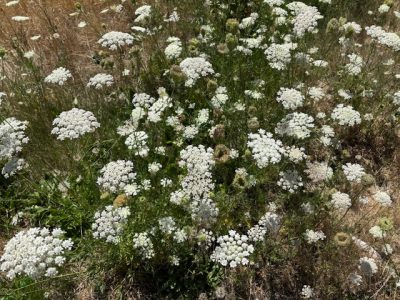By Dawn Pettinelli, UConn Home & Garden Education Center

Among the plants that have naturalized across this country, is the seemingly ubiquitous Queen Anne’s lace also known as the wild carrot. This herbaceous biennial originated around the Mediterranean region and western Asia. It is thought to be a wild ancestor of the carrot as both wild and domesticated carrots existed at least 5000 years ago. Anyone weeding or digging out Queen Anne’s lace from garden beds will notice the distinctive carrot smell of the taproots.
Pass almost any sunny roadside or field and you’ll find the delicate white lacy blossoms swaying in the breeze. Plants start out as small rosettes of fern-like, green leaves. The seeds can germinate throughout the growing season if enough moisture is present. Typically seeds germinate within a couple of years but they can remain viable for at least 7 years. A taproot develops where energy is stored for next year’s growth. The following spring, the plant produces more leaves, stalks and flowers. The lacy leaves are finely divided and tripinnate. The hairy, solid stem can grow up to 3 feet before the flower buds are formed.
Queen Anne’s lace blossoms typically appear from June through August in most areas. The tiny white flowers are clustered into a flat, terminal umbel from 2 to 4 inches across. Curiously, many flower heads have a single pinkish to purplish floret in the center. The color is due to the pigment, anthocyanin. For at least 150 years, botanists have been trying to figure out what purpose the dark colored floret serves. It is thought that perhaps it serves as an insect attractant but this remains to be confirmed.
Each floret on the umbel can produce 2 seeds. Since there might be 1000 florets making up the umbel, saying this plant is a prolific seeder is an understatement. In at least 35 states, it is considered a noxious weed as it displaces native vegetation. As the seeds ripen, the flower head curls inward like a closed fist or bird’s nest and turns brown. Eventually the dried seed head might detach from the stem and then it can be blown like a tumbleweed spreading its cache. This plant is especially problematic if it occurs where domesticated carrots are grown for their seed. Cross pollination could take place and the resulting seed would be useless. The seeds have hooked spines and can readily attach to cloth and fur.

Aside from its lovely, lacy flowers that hold up well in cut flower arrangements, Queen Anne’s lace serves as a host plant for the eastern black swallowtail caterpillar as well as providing a source of nectar for other butterfly species, bees and other pollinators.
Several seed companies offer varieties of Queen Anne’s lace that were bred or selected for their dark coloration. ‘Purple Kisses’ sports umbels in shades of dark purple and pink and is available from Johnny’s Seed. ‘Chocolate Lace’ from Seed Therapy comes in shades of burgundy, chocolate and dusty rose. Although I have not grown these varieties, I suspect they would also self-seed. A better option might be to try Ammi majus, called the Bishop’s flower or False Queen Anne’s lace. It is an annual with similar lacy, white flowers but I have not found it to be a prolific seeder especially if the flowers are used for cutting and not left to go to seed.
Being a member of the parsley (Apiaceae) family, Queen Anne’s lace is edible but not very flavorful. The flowers are sometimes used to make jelly. The root could be eaten when young but gets tough very fast. The seeds especially have been used for medicinal purposes for centuries. Reputedly this aromatic herb has many uses ranging from a love potion to soothing the digestive system, supporting the liver and for kidney and bladder diseases. If you are tempted to sample some Queen Anne’s lace, be very careful to identify it correctly. Other plants, such as poison hemlock have similar flowers and foliage but deadly outcomes.
As to how Queen Anne’s lace got its name, there are a number of anecdotes. Perhaps it resembled the lace collar or headdress of Queen Anne (1655-1714). Another story goes that she was tatting lace and pricked her figure leaving a drop of blood on the lace, representing the dark floret. Or it could be that the dark floret was thought to be the Queen and the white ones her maids. Geoffrey Grigson, an English botanist, conjectured that the name was in honor of St. Anne, the mother of the Virgin Mary and the patron saint of lacemakers.
However Queen Anne’s lace got its name, one has to be in awe of how widespread it has become. Because plants are short-lived but prolific seeders, one way to control it is to remove the flower heads before they go to seed. They do make delightful cut flowers so make use of them in arrangements. You get to enjoy them and there is less seed out there.
The UConn Home & Garden Education Center supports UConn Extension’s mission by providing answers you can trust with research-based information and resources. For gardening questions, contact us toll-free at (877) 486-6271, visit our website at homegarden.cahnr.uconn.edu, or reach out to your local UConn Extension center at cahnr.uconn.edu/extension/locations.
This article was published in the Hartford Courant August 23, 2025